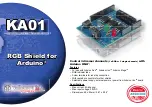
DocID17659 Rev 10
13/129
STM32L151x6/8/B, STM32L152x6/8/B
Functional overview
46
3.1
Low power modes
The ultralow power STM32L15xx6/8/B supports dynamic voltage scaling to optimize its
power consumption in run mode. The voltage from the internal low-drop regulator that
supplies the logic can be adjusted according to the system’s maximum operating frequency
and the external voltage supply:
•
In Range 1 (V
DD
range limited to 1.71-3.6 V), the CPU runs at up to 32 MHz (refer to
for consumption).
•
In Range 2 (full V
DD
range), the CPU runs at up to 16 MHz (refer to
consumption)
•
In Range 3 (full V
DD
range), the CPU runs at up to 4 MHz (generated only with the
multispeed internal RC oscillator clock source). Refer to
for consumption.
Seven low power modes are provided to achieve the best compromise between low power
consumption, short startup time and available wakeup sources:
•
Sleep
mode
In Sleep mode, only the CPU is stopped. All peripherals continue to operate and can
wake up the CPU when an interrupt/event occurs.
Sleep mode power consumption: refer to
•
Low power run
mode
This mode is achieved with the multispeed internal (MSI) RC oscillator set to the
minimum clock (65 kHz), execution from SRAM or Flash memory, and internal
regulator in low power mode to minimize the regulator's operating current. In the Low
power run mode, the clock frequency and the number of enabled peripherals are both
limited.
Low power run mode consumption: refer to
Table 20: Current consumption in Low
.
•
Low power sleep
mode
This mode is achieved by entering the Sleep mode with the internal voltage regulator in
Low power mode to minimize the regulator’s operating current. In the Low power sleep
mode, both the clock frequency and the number of enabled peripherals are limited; a
typical example would be to have a timer running at 32 kHz.
When wakeup is triggered by an event or an interrupt, the system reverts to the run
mode with the regulator on.
Low power sleep mode consumption: refer to
Table 21: Current consumption in Low
.
•
Stop
mode with RTC
Stop mode achieves the lowest power consumption while retaining the RAM and
register contents and real time clock. All clocks in the V
CORE
domain are stopped, the
PLL, MSI RC, HSI RC and HSE crystal oscillators are disabled. The LSE or LSI is still
running. The voltage regulator is in the low power mode.
The device can be woken up from Stop mode by any of the EXTI line, in 8 µs. The EXTI
line source can be one of the 16 external lines. It can be the PVD output, the
Comparator 1 event or Comparator 2 event (if internal reference voltage is on), it can
be the RTC alarm(s), the USB wakeup, the RTC tamper events, the RTC timestamp
event or the RTC wakeup.
•
Stop
mode without RTC
Stop mode achieves the lowest power consumption while retaining the RAM and
register contents. All clocks are stopped, the PLL, MSI RC, HSI and LSI RC, LSE and














































